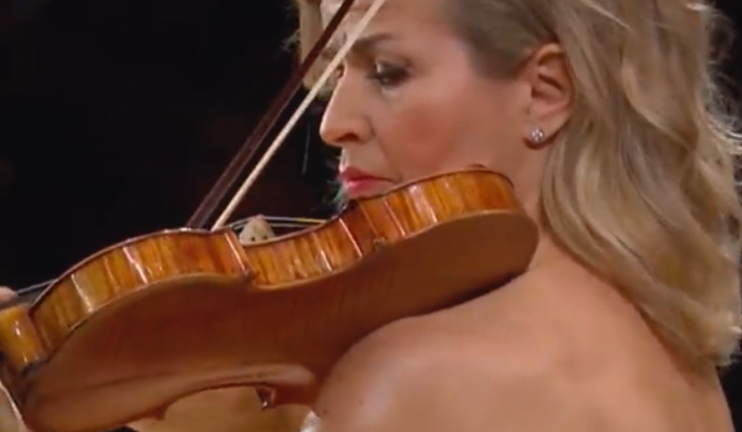
The Stradivarius and the Market

Ten years ago there unfolded a story, officially unconfirmed, but well-known in music circles, about the great German violinist Anne-Sophie Mutter (above). On the first day of her first visit to Australia, mid-rehearsal on Beethoven’s Violin Concerto with the Sydney Symphony Orchestra, Ms Mutter stepped unwittingly into the path of a wild gesticulation from over-excited chief conductor Vladimir Ashkenazy. Wedging his errant baton into the body of her violin, Ashkenazy tore the instrument from Ms Mutter’s hands, sending it spiraling to the floor of the Sydney Opera House.
Ms Mutter is known to play on either one of two priceless early 18th Century Stradivarius violins. Whilst she carried on gracefully, she was understandably upset by the incident. It was rumored a luthier was dispatched with haste from Paris to attend to the crisis. Mercifully, her instrument survived. The much-anticipated concert went ahead, and the SSO escaped infamy in the annals of classical music history. For a horrible moment, however, Mutter, Ashkenazy and the orchestra had held their collective breath beneath a cloud of bleak anxiety.
Contemplating the loss of a Stradivarius is a peculiarly torturous thing. Peculiar, because one would never willingly endanger such a jewel. Torturous, because the Stradivarius is one of those rare historical artefacts that holds unquestioned superiority over its long trail of descendents. To ruin a Stradivarius is to extinguish a preserved, functional manifestation of genius that modern man has lost the capacity to recreate. Indeed, upon the death of Antonio Stradivarius in 1737, violin making went the way of the Roman aqueduct, Damascan steel, and Callinicus of Heliopolis’ ‘Greek Fire’, the 7th Century super-weapon and ancient precursor to napalm.
One should judge the greatness of those lost inventions by both the magnitude of impact they had on the world, and the difficulty human beings have found in recapitulating the evident ‘magic’ of their design. One might also wonder if we aren’t, in 2022, on the precipice of consigning another truly great invention of functional genius to the dustbin of history — one more responsible for human flourishing than any of the aforementioned artifacts. So runs our dilemma in retaining the empirically-proven, but apparently impossible to recapture, magic, of supply-side market economics. In history, no other suite of reforms has so directly led to such rapid growth in material well being. When George Bush senior called it ‘Voodoo economics’, he perhaps only proved its magic: to the uninitiated, it seemed impossible such simple settings could induce such miraculous growth in productivity.
Like the Stradivarius, supply-sde economics didn’t simply appear in a vacuum. It had a long chain of tested antecedents. Its alternates had been tried and many had failed. Its antithesis, Keynesianism, had by the 1980’s been proven to run counter to the inherent disposition of a free and prosperous people.
And just as the Stradivarius was meant to serve as a vehicle for the greatest music in human history, so the supply-side market was meant to serve as a vehicle for the flourishing of the human race: its passions, its intellect, its love of freedom, and its deep want for unleashing the creativity of the individual. It was never about dogma or ideological conformity for its own sake. As Margaret Thatcher said famously in the Sunday Times in 1981, “Economics are the method; the object is to change the heart and soul.”
Unlike the Stradivarius, however, there is no excuse for the intellectual reservoir of free-market, pro-growth, low tax economics to run dry. Whilst Antonio Stradivarius worked alone, Thatcher, Reagan and their counterparts left deep philosophical wellsprings in their political wake.
It looked, for a fleeting moment, as if Liz Truss might surf that wake into a wave. But with her political failure, so now goes any hope of soon rediscovering that ‘magic’ of economic invention the world so enjoyed at the end of the 20th Century, and so desperately needs now.
As Anne-Sophie Mutter did that fateful day in Sydney in 2012, we are all now holding our breath, as a great symphony of human achievement is smashed recklessly against the rocks of time.
Ben Crocker is a Europa fellow for Common Sense Society, and Ramsay Centre for Western Civilsation Scholar, in Washington DC. His Substack is Crocker’s Columns.
Madam: Archbishop Fisher (July-August 2024) does not resist the attacks on his church by the political, social or scientific atheists and those who insist on not being told what to do.
Aug 29 2024
6 mins
To claim Aborigines have the world's oldest continuous culture is to misunderstand the meaning of culture, which continuously changes over time and location. For a culture not to change over time would be a reproach and certainly not a cause for celebration, for it would indicate that there had been no capacity to adapt. Clearly this has not been the case
Aug 20 2024
23 mins
A friend and longtime supporter of Quadrant, Clive James sent us a poem in 2010, which we published in our December issue. Like the Taronga Park Aquarium he recalls in its 'mocked-up sandstone cave' it's not to be forgotten
Aug 16 2024
2 mins







